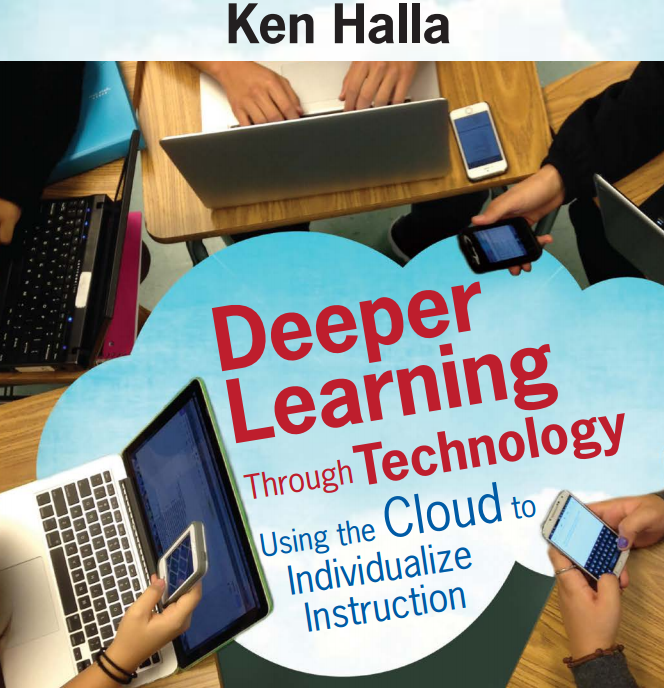While I have a lot of less traditional ways of teaching (in case you haven't figured it out from my blogs), I still do have the kids do some note taking. Here I have struggled in asking whether or not even this part of my teaching is up with the times. It was interesting this year when several of my AP students decided to do collective note taking using Google Docs. At first I was hesitant fearing that the kids were not paying attention (since they could communicate through the notes), but I checked in and watched their faces a lot (to see if they were laughing when they should not have been and paying attention when they should have been) and it seemed to work fairly well. But in talking to a fellow AP teacher as part of preparing for a summer institute I am doing tomorrow, we agreed that the way we learned is not necessarily the only way in that kids can take the traditional Cornell style notes, but also the type (which I like) where you split the page and add class notes to the ones you did while reading or even using web notes for the visual learner. Here is a nice way of looking at those differences.
Sunday, July 31, 2011
Friday, July 29, 2011
Chart on the Debt
I have the WashPost chart on the debt a few posts ago, but here is a similar (but different looking) one from the NYTimes.
Wednesday, July 27, 2011
Five Google+ Tips
Sorry to keep harping on G+, but I think the huddles feature in it as well as the circles will allow students to work better in groups outside of school or for that matter in different rooms in the same school or hey - how about between schools in different time zones at the same time - while working a collaborative project in Google Docs. Think of the possibilities! I found out about the tip from Freetech4teachers.
Tuesday, July 26, 2011
Reading Critically
Next Monday I am teaching a three hour course for AP students on preparing them for this fall (well for us in VA it is fall since we do not see kids until Sept 7th!). One of the things I will concentrate on will be reading for understanding. Well this is where my worlds collide. Another project I am working on is preparing teachers to integrate their e-books (and tons of ancillaries) into the classroom. Well it turns out that Patterns of Interaction, which is used for our World History I and II has a wonder section online which has a part of preparing students to read analytically as well as critiquing resources (including video), making higher level analysis and creating presentations. So one idea might be to have your students follow the fairly easy model as they read their chapters early in the year. My only issue is that I supplement our e-books with lots of websites which means my students have to be more on the ball in terms of organization (can you say Google Docs or e-folders).
Sunday, July 24, 2011
Glencoe Resources Aplenty
As I prepare for an in-service in late August to help our county's teachers grapple with our new e-books, I will be giving you updates on the free ancillaries as I learn of them. As usual Glencoe has the most free items online. If you go here you can find them for each of their books. Whether or not you use their books, the ancillaries are extremely rich and will give you tons of additional ways to present the material in a digital format. Included are videos, games, quizzes, links, puzzles and a lot of other items.
Friday, July 22, 2011
Make Multiple Calls at Once in G-mail
If you are like me, you have noticed that more and more parents have long distance phone numbers you need to calls to talk about your students. For that reason I use gmail's free phone call service a lot. While I am not sure why you would need it, you can now make two phone calls at once, putting one person on hold while you speak to another.
Thursday, July 21, 2011
Splitting the Computer Screen
I take a lot of flap (especially from fellow blogger "Panther Fan" about promoting how one splits a computer screen. In an Apple, you either have to pay for a $7 piece of software which allows you to do it fairly easily or you can just drag the ends of the browser and make it smaller or larger. It is much easier in a Microsoft based computer, though as you can see from the video above. So why would you want to do it. How many times have you printed an e-mail so you can read it while working on your laptop. For me, I have my students look at their e-book and then work on a project at the same time and then do the same myself when preparing lesson plans.
Monday, July 18, 2011
Amazing Graphic on US Debt
I never thought Americans would ever care about our national debt, but apparently I was wrong as evidenced by the attention in the last few weeks. Here is an amazing graphic which shows where the US has borrowed its money to reach our nearly $14 trillion debt. It also shows how much it has gone up each year since 2000.
Saturday, July 16, 2011
Comprehensive User Guide for Google+
Sorry to be so excited about Google+, but as I have said before it makes up for Facebook's shortcomings. What I especially like is that I can control who sees what and my "friends" can do the same. Hopefully it will be something that educators can set up with their students so questions can easily be asked and answered by students and even teachers after hours - not that kids don't already set up Facebook pages on their own for this purpose, but teachers aren't usually part of it. Here is the most comprehensive how to (videos, pictures, etc.) set up your account and use it.
The Cash Race for President
The NYTimes has a great interactive graphic where you can compare any of the Republicans with Obama and see in what regions of the US each has raised their cash.
Friday, July 15, 2011
e-books
Two years ago I asked to pilot an e-book for students at my school. We ended up doing it with all juniors. One other middle school also did it and that spread to 16 schools in our county this past year. Now we are almost definitely going to do it at all high schools thanks to the work of a ton of teachers, administrators, and, of course students. Here is a clip from a DC television channel tonight which shows some of the things e-books can do (and is rather balanced in its presentation) and here a cable channel clip one of one of my students, myself and my class doing a lot of the same.
Add Twitter & Facebook Feed to G+
So you can now add a Twitter and/or Facebook feed to the top of your Google+ page (see picture above. Just go here for the information.
e-textbook
I am huge proponent of moving textbooks online, especially since the major textbook companies have finally figured it out and now have a number of digital ancillaries that come with the books. But every one in while they do server maintenance or have too many people on at the same time. At that point, I tell my students to go here for a complete US history e-book.
Thursday, July 14, 2011
Google Surveys
I started using Google surveys a year ago to save time. For example I got our school to use them for our graduation to save time on all our jobs and another teacher used it for feedback on a writing center he is starting. The item above I found on Twitter at tombarrett. It is great and includes things such as "exit tickets" for students, signing up for equipment (although we use Google excel for that), and a ton of other things. It is well worth the 3 minutes it takes to go through it as I bet you are doing at least five things with paper that it suggests to do more quickly online (and could easily be done by the students or staff at home if you are lacking on computers).
Wednesday, July 13, 2011
I am actually working until August 8th (when some of you are probably going back to school) and so am still in school mode. I just saw this article on how Amazon.com is trying to get a referendum passed in CA limiting the amount of taxes it has to pay for its online services. It might be what I start the year with for my AP kids as it brings up lobbying, referendum, initiatives, propositions, taxes and who pays for government services and it wraps it all so nicely with technology.
The Debt, Obama Fundraising
Franz beat me to the punch for the fundraising for Obama, but above is the caucus from NYTimes which has a short video on politics every few days as you can see above.
Monday, July 11, 2011
Drawings in Prezi
I have done a few posts of Prezi before, but today they announced that they have added a bunch of different drawings (triangles, squares, etc.) to the different things you can add to a presentation. Above is a short video on it.
Friday, July 8, 2011
Google + Circles for the Classroom
I found this from a Tweet from "mrpotter". It is exactly what I was looking for to be able to use in the classroom. It details how you could create a "circle" which is where you could put your students. Then when you (or they post something) you can set it to only send to that room so your students could be on at night and you could see their questions or even better they could see each others'. Also you can have up to ten people video chat at the same time which would be great for students working on projects at home (and what is scaring Facebook since you can only chat with one other there).
Thursday, July 7, 2011
Google + For Teachers
I hope you are going to be hearing a lot more about Google + as it might help teachers where Facebook has not. While Facebook is just a tremendous way that teachers could have kids talking about assignments after hours, most school systems ban it and in some cases for good reason. But Google+ allows you to create "circles" that would allow you to say, make a class for your students and they could only see what you put there and not what you might put in a circle of your personal friends. Imagine the benefits if people joined this. There are four parts of Google + called circles, huddles, hangouts and sparks which you can find out about here. Above is a short video showing you what it looks like if you are able to get an invitation to the beta testing of Google +. Here is some more information on sharing pictures in it and more ideas for the classroom..
Subscribe to:
Posts (Atom)














